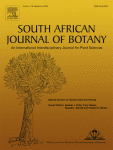Ver ítem
- xmlui.general.dspace_homeCentros e Institutos de InvestigaciónCIAP. Centro de Investigaciones AgropecuariasInstituto de Fisiología y Recursos Genéticos VegetalesArtículos científicosxmlui.ArtifactBrowser.ItemViewer.trail
- Inicio
- Centros e Institutos de Investigación
- CIAP. Centro de Investigaciones Agropecuarias
- Instituto de Fisiología y Recursos Genéticos Vegetales
- Artículos científicos
- Ver ítem
Differential salt-stress response during germination and vegetative growth in in vitro selected somaclonal mutants of Cenchrus ciliaris L.
Resumen
Four somaclonal mutants (S1, S4, S6 and M10) and their parental Cenchrus ciliaris L. cultivar Biloela were characterized under salinity conditions at germination and vegetative growth stages. Seeds of all somaclonal mutants had higher germination percentages than cv. Biloela seeds in the control and salt treatments. At 150 mM, germination was significantly higher in M10, S6 and S4 (72.3%, 66.3% and 61.8%, respectively) than in cv. Biloela (35.5%). Mutants
[ver mas...]
Four somaclonal mutants (S1, S4, S6 and M10) and their parental Cenchrus ciliaris L. cultivar Biloela were characterized under salinity conditions at germination and vegetative growth stages. Seeds of all somaclonal mutants had higher germination percentages than cv. Biloela seeds in the control and salt treatments. At 150 mM, germination was significantly higher in M10, S6 and S4 (72.3%, 66.3% and 61.8%, respectively) than in cv. Biloela (35.5%). Mutants grown under salinity along with cv. Biloela for 35 days had a different relative growth rate. S6 had the highest growth rate, indicating its potential tolerance to salt stress, whereas M10 was the most sensitive, with Bi, S4 and S1 being intermediate tolerant genotypes. Catalase enzyme activity (CAT) in M10 decreased in response to salt stress and was significantly associated with malondialdehide content, suggesting salt injury, whereas higher levels of CAT activity in S6 during salt stress were associated with increased salinity tolerance. The present results indicate that somaclonal variation and in vitro mutagenesis offer an effective tool for improvement of C. ciliaris because the somaclonal mutants showed differential tolerance to salt stress with respect to their parental and could be a better choice for use in a breeding program.
[Cerrar]

Fuente
South African Journal of Botany 87 : 157-163 (July 2013)
Fecha
2013-07
ISSN
0254-6299
Formato
pdf
Tipo de documento
artículo
Palabras Claves
Derechos de acceso
Abierto
 Excepto donde se diga explicitamente, este item se publica bajo la siguiente descripción: Creative Commons Attribution-NonCommercial-ShareAlike 2.5 Unported (CC BY-NC-SA 2.5)
Excepto donde se diga explicitamente, este item se publica bajo la siguiente descripción: Creative Commons Attribution-NonCommercial-ShareAlike 2.5 Unported (CC BY-NC-SA 2.5)


